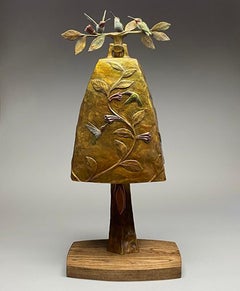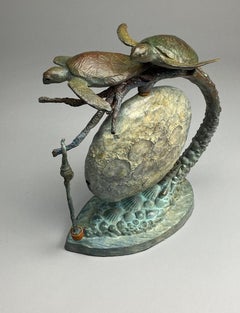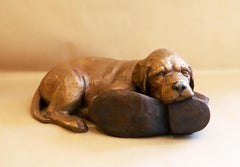Want more images or videos?
Request additional images or videos from the seller
1 of 2
Greg KelseyAnother Drink21st Century
21st Century
$3,300List Price
About the Item
- Creator:Greg Kelsey (1971, American)
- Creation Year:21st Century
- Dimensions:Height: 18 in (45.72 cm)Width: 7 in (17.78 cm)Depth: 5 in (12.7 cm)
- Medium:
- Movement & Style:
- Period:
- Condition:
- Gallery Location:Colorado Springs, CO
- Reference Number:1stDibs: LU2741215961362
About the Seller
5.0
Vetted Professional Seller
Every seller passes strict standards for authenticity and reliability
Established in 1979
1stDibs seller since 2024
23 sales on 1stDibs
Typical response time: 15 hours
Authenticity Guarantee
In the unlikely event there’s an issue with an item’s authenticity, contact us within 1 year for a full refund. DetailsMoney-Back Guarantee
If your item is not as described, is damaged in transit, or does not arrive, contact us within 7 days for a full refund. Details24-Hour Cancellation
You have a 24-hour grace period in which to reconsider your purchase, with no questions asked.Vetted Professional Sellers
Our world-class sellers must adhere to strict standards for service and quality, maintaining the integrity of our listings.Price-Match Guarantee
If you find that a seller listed the same item for a lower price elsewhere, we’ll match it.Trusted Global Delivery
Our best-in-class carrier network provides specialized shipping options worldwide, including custom delivery.You May Also Like
VALTON Charles. The Griffin Marco. Patinated bronze. Marble base. Signed.
By Charles Valton
Located in Paris, FR
The Griffin Marco. Patinated bronze. Marble base. Signed and titled.
Charles Valton was a French sculptor known for his works created in the animalier style, a 19th-century movement ...
Category
Late 19th Century Realist Figurative Sculptures
Materials
Bronze
$4,179
H 13.39 in Dm 16.93 in
Fisherman
By Francesco Messina
Located in Roma, RM
Francesco Messina (Linguaglossa 1900 – Milan 1995), Fisherman (1930)
Bronze sculpture measuring 131 x 52 x 65 cm, signed and dated 1930 on the base.
Francesco Messina’s Fisherman w...
Category
1930s Realist Figurative Sculptures
Materials
Bronze
A la fontaine
By Émile Nestor Joseph Carlier 1
Located in Mc Lean, VA
Nice 19th-century cast with rich, brown patina by French sculptor Emile-Joseph-Nestor Carlier. Carlier frequently created large, multi-figural group sculptures. These are dramatic an...
Category
Late 19th Century Realist Figurative Sculptures
Materials
Bronze
Le cheval demi-sang arabe
By Antoine-Louis Barye
Located in Mc Lean, VA
A nineteenth-century cast of Antoine-Louis Barye's Le cheval demi-sang arabe (no. A125-Poletti; A148-Pivar), with nice patina.
Poletti and Richarme, Barye: ...
Category
Late 19th Century Realist Figurative Sculptures
Materials
Bronze
Life Size Sculpture of Male Head in Patina Bronze "Diadji"
By William J Rushton
Located in New York, NY
Bronze life-size male head with a dark brown patina. Sculpted in Florence Italy and casted in bronze just outside of the city. This is an earlier piece that holds a distinctly differ...
Category
2010s Realist Figurative Sculptures
Materials
Bronze
$6,000
H 15 in W 8.5 in D 9 in
Life Size Sculpture of Male Head in Patina Bronze "Giorgi"
By William J Rushton
Located in New York, NY
Bronze life-size male head with a dark brown patina.
Rushton sculpts all of his busts using live models over the course of multiple sittings. While realistic and classical in charac...
Category
2010s Realist Figurative Sculptures
Materials
Bronze
$6,500
H 11 in W 9 in D 9 in
Bronze, Monkey With Skull, 1900, German, Signed
Located in Eltville am Rhein, DE
Hugo Wolfgang Reinhard
Oberlahnstein 1853 - 1900 Berlin
Monkey with Skull, circa 1900
Bronze, signed
Foundry: Gladenbeck "HG"
Size: approx. 12.5 x 6 x 8 cm, plus 2 cm base
Rare cas...
Category
Early 1900s Realist Figurative Sculptures
Materials
Bronze
$4,538
H 4.93 in W 2.37 in D 3.15 in
Else FÜRST (1873-1943), Fasane Foundry stamp of the Berlin foundry Kraas
Located in Berlin, DE
Else Fürst was a
German sculptor and medalist who was murdered by the Nazis.
Biographical data:
Bronze
signed
Foundry stamp of the Berlin foundry Kraas.
25 x 73 cm
Born: June 25,...
Category
1930s Realist Figurative Sculptures
Materials
Bronze
$4,717
H 9.85 in W 28.75 in D 6.7 in
"Ex Nihilo Fragment 6", Frederick Hart, Figurative Bronze Sculpture, 39X23X12 in
By Frederick Hart
Located in Dallas, TX
"Ex Nihilo Fragment 6" by Frederick Hart is a figurative bronze with the edition of 55/65. Ex Nihilo Fragment No. 6, detail from the full-scale plaster for the final stone sculpture of Ex Nihilo, was commissioned as part of The Creation Sculptures at Washington National Cathedral...
Category
Early 2000s Realist Figurative Sculptures
Materials
Bronze
Frederick Hart"Ex Nihilo Fragment 6", Frederick Hart, Figurative Bronze Sculpture, 39X23X12 in, 2005
$45,000
H 43 in W 31 in D 18 in
"Traditions", James Muir, Bronze, A&M, 6 Core Values, Figurative Sculpture
Located in Dallas, TX
As the six core values are perceived to be inseparable in the formation of character. I see them to also be inseparable in the rendering of a physical artistic depiction. I view them...
Category
2010s Realist Figurative Sculptures
Materials
Bronze
$48,000
H 60 in W 40 in D 28 in
More From This Seller
View AllFive Hummingbirds
By James Moore
Located in Colorado Springs, CO
Edition 6/30. Original bronze bell sculpture by artist James Moore. Inscribed.
Category
21st Century and Contemporary Realist Figurative Sculptures
Materials
Bronze
Sea Turtle Serenade
By James Moore
Located in Colorado Springs, CO
Edition 5/30. Original bronze bell sculpture by artist James Moore. Inscribed.
Category
21st Century and Contemporary Realist Figurative Sculptures
Materials
Bronze
In the Rough
Located in Colorado Springs, CO
Original bronze sculpture by E.C. Wynne.
Edition #110/125.
Signed on bronze.
Category
21st Century and Contemporary Realist Sculptures
Materials
Bronze
Nap Time (Puppy on a Boot)
Located in Colorado Springs, CO
Original bronze sculpture by artist Andrea Wilkinson. Edition 11/30. Artist signature inscribed on sculpture.
Category
21st Century and Contemporary Realist Figurative Sculptures
Materials
Bronze
Pug
Located in Colorado Springs, CO
Bronze sculpture by artists Bill and Renee Shisler. Edition 4/25.
Category
21st Century and Contemporary Realist Figurative Sculptures
Materials
Bronze
Wille (Peekapoo)
Located in Colorado Springs, CO
Bronze sculpture by artists Bill and Renee Shisler. Edition 4/25.
Category
21st Century and Contemporary Realist Figurative Sculptures
Materials
Bronze
Still Thinking About These?
All Recently ViewedMore Ways To Browse
Drinking Sculptures
Vincent Glinsky Sculpture
Vincent Glinsky
Virgen De La Caridad Del Cobre
Wendy Saxon Brown
Wesley Fleming
Willem Degroot
William Debilzan
William Morris Glass Art
Winged Hat Hermes
Wladimiro Politano
3 Wise Monkeys
A Moreau Angels
Alex Katz Cut Out
Alexis Silk Glass
Amber Cowan
Ancizar Marin Climber
Andy Warhol Dunny


